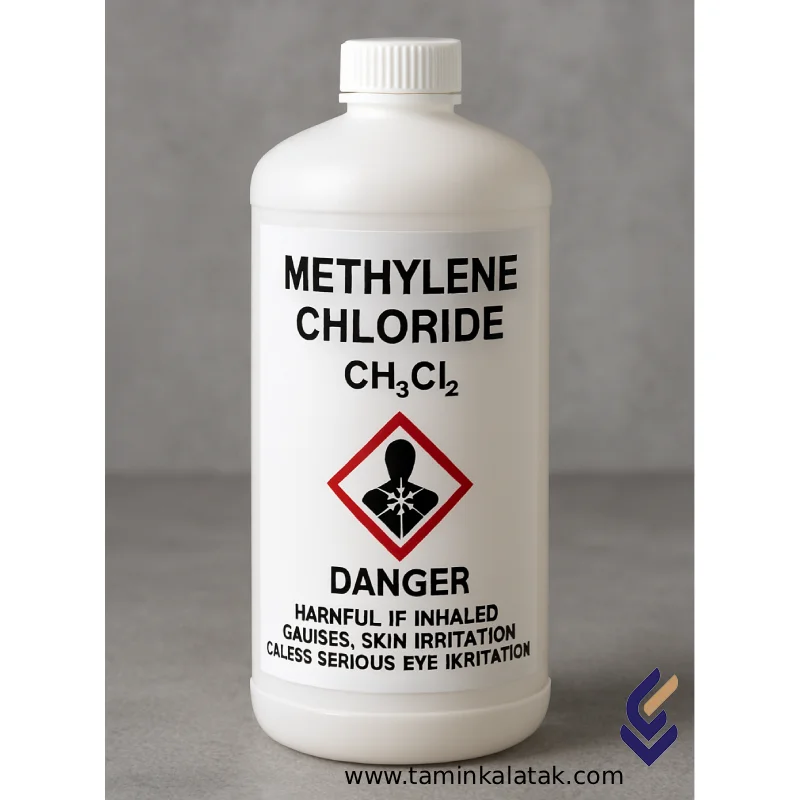Methylene chloride
Dichloromethane (DCM), also known as Methylene Chloride, is a colorless, volatile, and powerful chlorinated solvent with a mild, sweet odor.
It is widely used across various industries due to its exceptional solvent power, rapid evaporation rate, and chemical stability.
DCM is recognized globally as one of the most versatile and effective solvents in coatings, pharmaceuticals, adhesives, polymers, and chemical processing.
Chemical Structure and Identification
-
Chemical Formula: CH₂Cl₂
-
Molecular Weight: 84.93 g/mol
-
IUPAC Name: Dichloromethane
-
CAS Number: 75-09-2
-
Structure: One carbon atom bonded to two chlorine and two hydrogen atoms, forming a tetrahedral geometry.
Physical and Chemical Properties
| Property | Value |
|---|---|
| Physical State | Clear, colorless liquid |
| Odor | Sweet and mild |
| Boiling Point | 39.6 °C |
| Melting Point | −96.7 °C |
| Density (20 °C) | 1.322 g/cm³ |
| Vapor Pressure (20 °C) | 47.3 kPa |
| Water Solubility | 20 g/L |
| Refractive Index (nD20) | 1.4244 |
| Viscosity (25 °C) | 0.43 mPa·s |
| Flammability | Non-flammable (but vapor is toxic and heavier than air) |
Key Advantages
-
Excellent solvent power for resins, fats, waxes, and many polymers
-
Fast evaporation with no greasy residues
-
Good chemical stability under standard conditions
-
Non-flammable, safer than many hydrocarbon-based solvents
-
Broad industrial usability, from paints to pharmaceuticals
Limitations and Safety Concerns
-
Toxic via inhalation or prolonged exposure — affects the nervous system and liver
-
Classified as a suspected carcinogen by several regulatory agencies
-
Ozone-depleting potential when released into the atmosphere
-
Restricted use in some countries due to environmental and occupational safety regulations
Major Industrial Applications
1. Paints and Coatings
-
Paint and varnish remover
-
Solvent for resins, lacquers, and coatings
2. Pharmaceuticals
-
Extraction of active pharmaceutical ingredients (API)
-
Solvent for crystallization and purification processes
3. Plastics and Polymers
-
Blowing agent in polyurethane foam production
-
Solvent in adhesives and sealant formulations
4. Food and Beverage Industry
-
Used in decaffeination of coffee and tea (under strictly controlled conditions for residue limits)
5. Laboratory and Industrial Uses
-
Degreasing and cleaning of metal parts
-
Intermediate in organic synthesis and fine chemical production
Health, Safety, and Storage
Main Hazards
-
Toxic by inhalation, ingestion, or skin contact
-
May cause dizziness, headache, or central nervous system depression
-
Prolonged exposure can damage liver and lungs
Personal Protective Equipment (PPE)
-
Chemical-resistant gloves (neoprene or Viton)
-
Safety goggles and face shield
-
Organic vapor respirator or chemical fume hood required during use
Storage Conditions
-
Store in tightly sealed metal or HDPE containers
-
Keep away from heat, open flames, and direct sunlight
-
Maintain in a cool, dry, well-ventilated area
Emergency Measures
-
Skin contact: Wash thoroughly with soap and water
-
Eye contact: Rinse with water for at least 15 minutes
-
Inhalation: Move to fresh air and seek medical attention immediately
Summary
Methylene Chloride (Dichloromethane) remains an essential industrial solvent due to its high efficiency, versatility, and non-flammable nature.
However, its toxicological and environmental impact requires strict adherence to safety protocols, ventilation standards, and regulatory guidelines.
When handled responsibly, DCM offers unmatched performance in numerous industrial and chemical processing applications.
Applications
| Applications | , , , |
|---|
Methylene chloride
| Products | Grade | Boiling Point | Density (g/mm3) | Melting Point | Applications | Data Sheet | MSDS |
|---|---|---|---|---|---|---|---|
| Methylene chloride | 39,6 °C | 13.255,00 | -96,7 °C | Waxes Resins Solvents |







